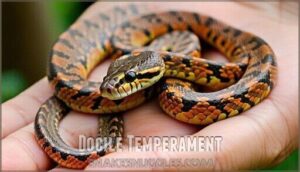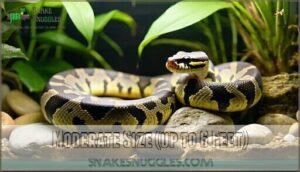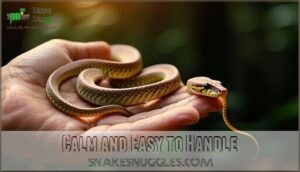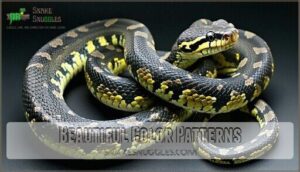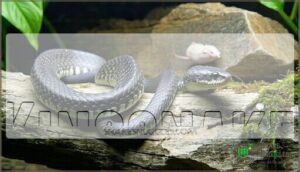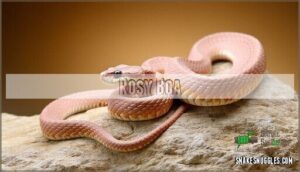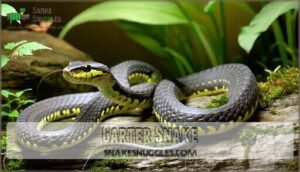This site is supported by our readers. We may earn a commission, at no cost to you, if you purchase through links.

Each species transforms nervous beginners into confident keepers through their forgiving nature and predictable behaviors, but choosing the right match depends on factors most people overlook.
Table Of Contents
- Key Takeaways
- Ball Python
- Corn Snake
- Kingsnake
- Rosy Boa
- Garter Snake
- Frequently Asked Questions (FAQs)
- What is the most popular snake to have as a pet?
- What is the best beginner snake?
- What is the most common type of snake?
- What is the hardest pet snake to take care of?
- How often should pet snakes be fed?
- Are there any legal restrictions on owning snakes?
- What are the signs of a sick snake?
- How do you safely introduce a new snake?
- Can pet snakes be trained to respond to commands?
- What initial setup costs should I expect?
- Conclusion
Key Takeaways
- Ball pythons are your best bet for beginners – They’re gentle, manageable at 6 feet, and offer over 500 color morphs with 30-year lifespans.
- Corn snakes give you the easiest care experience – These calm 3-5 foot snakes handle beautifully and display stunning orange-red patterns without complex requirements.
- Size matters when choosing your first snake – Rosy boas max out at 3 feet for tight spaces, while garter snakes stay under 4 feet and remain active during daylight hours.
- You’ll face 20+ year commitments with proper care – Most popular breeds live decades, so factor in long-term housing, feeding costs, and veterinary needs before purchasing.
Ball Python
You’ll find Python regius, commonly called the ball python, makes an excellent first snake because of its calm personality and manageable size reaching up to six feet.
With over 500 stunning color morphs available and a lifespan extending up to 30 years, this West African native offers both beauty and long-term companionship for dedicated keepers.
Docile Temperament
Ball pythons (Python regius) possess a gentle temperament that makes them ideal beginner snakes. Their calm nature rarely leads to defensive behavior, creating safe handling experiences for new owners.
Key temperament traits include:
- Docile species that tolerate regular handling without stress
- Gentle temperament reduces bite risk during child safety interactions
- Snake personality remains consistent with proper temperament training
These docile temperaments make handling techniques straightforward for beginners.
Variety of Color Morphs
With over 4,000 documented ball python morphs, you’re entering a world of remarkable color genetics and pattern variation. Morph breeding has produced stunning combinations like Piebald, Clown, and Banana morphs through selective color mutation programs.
Ball python breeders have developed over 4,000 stunning color morphs through selective breeding programs
These breed markings range from pure white albinos to vibrant yellows, showcasing nature’s breathtaking snake colors and morph genetics diversity. Some breeders use selective breeding techniques to create unique color variations.
Moderate Size (up to 6 Feet)
Unlike larger Red-Tail Boas, Ball Pythons (Python regius) won’t outgrow your apartment. These constrictors generally reach 4-6 feet, making them perfect starter snakes.
You’ll need a snake habitat with:
- 40-gallon minimum enclosure size for adults
- 4′ x 2′ x 2′ floor space for proper movement
- Secure lid with proper ventilation systems
- Temperature gradients matching natural behavior patterns
Their manageable snake length means easier handling techniques and reasonable care requirements.
Long Lifespan (up to 30 Years)
Longevity factors determine whether your Ball Python reaches its full 30-year potential. Ball pythons usually live 20-30 years in captivity, with some reaching 40+ years.
Proper health monitoring throughout their aging process is essential. Their gentle temperament makes regular veterinary checkups easier.
Senior care becomes essential as your snake ages, ensuring ideal snake longevity through dedicated attention to their evolving needs.
Corn Snake
You’ll find Pantherophis guttatus practically takes care of itself, making it the perfect starter snake with its calm temperament and striking orange-red patterns marked by darker blotches.
This North American native reaches a manageable 3-5 feet and can live up to 20 years with proper care, giving you decades to appreciate its beautiful morphological variations.
Calm and Easy to Handle
Corn snakes (Pantherophis guttatus) make handling feel like second nature. Their gentle temperament shines through every interaction, making them perfect for beginners who want to build confidence. You’ll find these docile species rarely stress during routine care, unlike more defensive snakes.
- Snake handling tips: Move slowly and support their body weight
- Gentle species that tolerate regular interaction without aggression
- Calm behavior makes them ideal classroom pets and family companions
- Easy care requirements with minimal handling restrictions
- Docile nature means they rarely bite, even when startled
Their calm temperament rivals that of ball pythons.
Beautiful Color Patterns
Beyond their gentle nature, corn snakes display stunning pattern variations through genetic diversity. Over 800 corn snake color morphs exist in today’s market, featuring everything from classic saddle patterns to striking stripes.
Morph genetics produce iridescence effects and scale shine that rival any Ball Python. Pattern genetics create unique snake camouflage adaptations, making each specimen a living masterpiece of natural artistry.
Small to Medium Size (up to 5 Feet)
At roughly 3-5 feet in total length, corn snakes offer the perfect balance for new snake owners. You’ll find these beginner-friendly options ideal for most living spaces. Here are five key size advantages:
- Manageable enclosure requirements – A 40-gallon tank works perfectly
- Easy handling techniques – Their moderate weight prevents strain
- Reasonable feeding tips – Adult mice are appropriately sized prey
- Simple snake habitat setup – Less space means easier temperature control
- Practical pet care routine – Cleaning and maintenance stay manageable
This docile species remains comfortable to handle while providing an impressive serpentine presence.
Long Lifespan (up to 20 Years)
With proper care, corn snakes (Pantherophis guttatus) can live up to 20 years, making them excellent long-term companions. This impressive lifespan requires consistent attention to their specific needs:
- Health monitoring through regular veterinary checkups and observation of behavioral changes
- Dietary needs including appropriately-sized frozen-thawed rodents every 7-14 days
- Habitat maintenance with proper temperature gradients, humidity levels, and clean substrates
Their longevity factors depend heavily on your commitment to these essential care requirements.
Kingsnake
You’ll find kingsnakes (Lampropeltis species) fascinating due to their diverse subspecies and naturally calm temperament that makes handling straightforward.
These moderate-sized constrictors reach up to 4.5 feet and display striking banded patterns, though you should know they’re ophiophagous, meaning they’ll eat other snakes in wild settings.
Variety of Species and Subspecies
Which kingsnake subspecies fits your setup? Lampropeltis contains roughly 26 species and 45 subspecies with distinct color genetics and morphology. Species classification includes Eastern Kingsnakes (L. g. getula) and Speckled Kingsnakes (L. g. holbrooki). These beginner pet snakes showcase habitat diversity across North America.
Pet snake species offer varied patterns through natural snake morphology rather than hybrid breeding programs. Understanding the kingsnake geographic range is essential for creating suitable environments for these pets.
Docile and Non-aggressive
These docile species make beginner-friendly options shine through their calm temperament and gentle handling characteristics. Kingsnakes (Lampropeltis spp.) offer safe interaction without aggressive behaviors, creating an ideal safe handling experience for new owners.
- Calm breeds rarely bite even when startled or threatened
- Docile nature allows confident handling during routine maintenance tasks
- Snake temperament remains consistent across most Lampropeltis subspecies
- Beginner snakes benefit from kingsnakes’ predictable, non-defensive responses
- Safe interaction comes naturally due to their naturally relaxed disposition
Moderate Size (up to 4.5 Feet)
At 4.5 feet maximum, kingsnakes hit the sweet spot for pet snake breeds. Their moderate length makes snake handling techniques easier to master. Most snake habitat setups accommodate kingsnakes comfortably.
Unlike Ball Pythons reaching six feet, kingsnakes stay manageable throughout their lives, perfect for beginners learning proper snake care. You won’t need massive terrariums like larger species require.
Eat Other Snakes in The Wild
Unlike Ball Pythons or Corn Snakes, the King Snake earned its title through Cannibalistic Snake Species behavior. This species demonstrates exceptional Evolutionary Advantages through Interspecies Competition, literally eating the competition. Here’s what makes them nature’s ophiophagous predators:
- Venomous prey consumption (rattlesnakes, cottonmouths, copperheads)
- Same-species cannibalism during territory disputes
- Immunity to snake venoms through specialized proteins
- Habitat Impact reduction by controlling snake populations
- Strategic Prey Selection across multiple Snake Species
Kingsnake ophiophagy creates fascinating pet dynamics.
Rosy Boa
You’ll find the rosy boa (Lichanura trivirgata) perfect if you want a gentle snake that won’t stress you out during handling sessions.
These compact boas max out at three feet, making them manageable for beginners while their natural burrowing instincts create fascinating terrarium displays.
Gentle and Tolerant of Handling
Rosy boas (Lichanura trivirgata) are perfect for beginners seeking a gentle giant with minimal bite risk. Their calm temperament allows frequent handling sessions, making them ideal for child interaction under supervision.
Unlike Ball Python or Corn Snake alternatives, rosy boas rarely show defensive behaviors. Their docile nature stems from temperament genetics, creating excellent snake socialization opportunities for new owners.
Small Size (up to 3 Feet)
The Lichanura trivirgata maxes out around 3 feet, making it perfect for beginners worried about space. This compact size offers real advantages for pet care:
- Small enclosure requirements save money and room
- Easy handling techniques for nervous new owners
- Beginner-friendly options without ball pythons’ bulk
Unlike corn snakes that stretch longer, rosy boas stay manageable. Their petite frame means standard 40-gallon tanks work perfectly for adult snake habitat needs.
Long Lifespan (up to 15 Years)
Looking for longevity factors in pet snake breeds? This species (Lichanura trivirgata) generally lives 10-15 years with proper health monitoring and diet optimization. Their aging process differs from larger species:
| Species | Lifespan |
|---|---|
| Rosy Boa | 10-15 years |
| Ball Python | 20-30 years |
| Corn Snake | 15-20 years |
Snake longevity depends on consistent care and lifespan extension practices through ideal husbandry.
Burrowing Behavior
Beyond their impressive lifespan, rosy boas (Lichanura trivirgata) exhibit fascinating digging habits that set them apart from ball pythons and corn snakes. Their tunnel systems require thoughtful enclosure design.
You’ll need:
- Loose substrate mix – cypress mulch combined with sand mimics natural soil preference
- Strategic hide boxes – place them at different substrate depths for varied burrow design options
- Deep enclosure base – minimum 6 inches allows proper snake habitat exploration and natural snake behavior expression
Garter Snake
You’ll find Thamnophis sirtalis, the common garter snake, offers a compact 2-4 foot size that’s perfect for beginners who want an active, daytime companion.
These hardy snakes display striking striped patterns in yellow, red, or blue combinations, and they’re abundant in wild populations, making them both accessible and conservation-friendly choices.
Small Size (up to 4 Feet)
Garter snakes pack big personality into compact bodies. These beginner-friendly options max out at 4 feet, making them perfect for small pet care situations.
Their manageable size means mini enclosures work great – you won’t need massive snake habitat setups like corn snakes or ball pythons require.
Handling tips become simpler with smaller snakes, and feeding options stay budget-friendly with appropriately-sized prey.
Active and Diurnal
Unlike Ball Pythons and Corn Snakes that prefer nocturnal habits, garter snakes show Diurnal Habits with active Daytime Behavior. This Nocturnal Contrast means you’ll observe more Snake Activity during daylight hours.
Their diurnal nature requires proper Basking Requirements with heated spots for thermoregulation, making them more interactive pets than typical nocturnal species like Kingsnake or Western Hognose Snake.
Variety of Color Patterns
You’ll discover garter snakes showcase outstanding color morphs through diverse pattern genetics. Their scale pigmentation creates stunning variations, from classic stripes to checkered designs.
Snake camouflage patterns range from bright reds to subtle earth tones. Breeding techniques have produced fascinating morphs, making these pet snake breeds increasingly popular among enthusiasts seeking affordable alternatives to ball pythons and corn snakes.
Commonly Found in The Wild
North America’s most widespread serpent, you’ll encounter Garter Snake (Thamnophis sirtalis) in Wild Snake Habitats from Canada to Central America. Unlike venomous species, these docile reptiles thrive in diverse ecosystems—wetlands, forests, grasslands, and suburban areas.
Their notable adaptability and extensive Snake Migration Patterns make them perfect ambassadors for Snake Conservation education nationwide.
Frequently Asked Questions (FAQs)
What is the most popular snake to have as a pet?
Ironically, the serpent that once tempted humanity now captivates us as companions. Ball pythons (Python regius) reign dominant, with their gentle temperament making them perfect for first-time owners seeking control.
What is the best beginner snake?
You’ll want a ball python (Python regius) or corn snake (Pantherophis guttatus). Ball pythons stay manageable at 3-5 feet with docile temperaments.
Corn snakes offer vibrant colors, forgiving care requirements, and rarely bite.
What is the most common type of snake?
Like searching for a needle in nature’s haystack, you’ll find the common garter snake (Thamnophis sirtalis) reigns dominant.
This adaptable species dominates North America, thriving from coast to coast with outstanding ecological success.
What is the hardest pet snake to take care of?
You’ll find Green Tree Pythons (Morelia viridis) challenging due to their precise temperature, humidity, and arboreal setup requirements.
They’re defensive and difficult to care for without proper conditions, requiring expert-level husbandry skills.
How often should pet snakes be fed?
You’ll feed adult snakes every 1-2 weeks, while younger snakes need feeding twice weekly.
Age and size determine frequency – think of it as their metabolic sweet spot for ideal health.
Are there any legal restrictions on owning snakes?
Yes, you’ll face restrictions depending on your location. Some states prohibit over 30 venomous species, while fourteen states require permits for exotic animals.
Local laws often impose stricter rules than state regulations, so check both before purchasing.
What are the signs of a sick snake?
When your snake’s acting sluggish, it’s nature’s SOS signal. Watch for lethargy, appetite loss, and open-mouth breathing. Wheezing, nasal discharge, and clicking sounds signal trouble brewing.
How do you safely introduce a new snake?
Quarantine new arrivals for three months minimum in a separate room. Use dedicated equipment, wash hands between handling, and monitor for parasites or illness before introducing to your collection.
Can pet snakes be trained to respond to commands?
Unlike cats or dogs, you can’t train pet snakes to respond to specific commands. Snakes are also not known to respond to explicit human commands.
However, they can learn basic conditioning through consistent handling and routine recognition.
What initial setup costs should I expect?
Budget around $300-500 for initial setup costs. You’ll need a terrarium, heating equipment, substrate, water bowl, and hiding spots.
Expect to pay between $300-$500 for everything you need to get started to create a proper habitat.
Conclusion
Choosing among these most popular pet snake breeds requires matching temperament to your experience level, space constraints to adult size requirements, and care commitment to lifespan expectations. Ball pythons (Python regius) excel for collectors seeking morphological diversity, while corn snakes suit beginners wanting vibrant patterns without complex husbandry. Kingsnakes offer hearty appetites and hardy constitutions, rosy boas thrive in compact setups, and garter snakes provide active daytime observations.
Research local reptile conservation efforts—many wild populations face habitat pressure, making responsible captive breeding increasingly important for preserving genetic diversity.
- https://qualitycage.com/blogs/quality-snake-care/best-pet-snakes
- https://www.petmd.com/reptile/ball-python-care-sheet
- https://www.wiseguyreports.com/reports/pet-snakes-market
- https://www.bsmpartners.net/insights/reptiles-and-small-mammals-an-industry-perspective/
- https://allanspetcenter.com/the-top-10-best-snake-pets-to-own/

